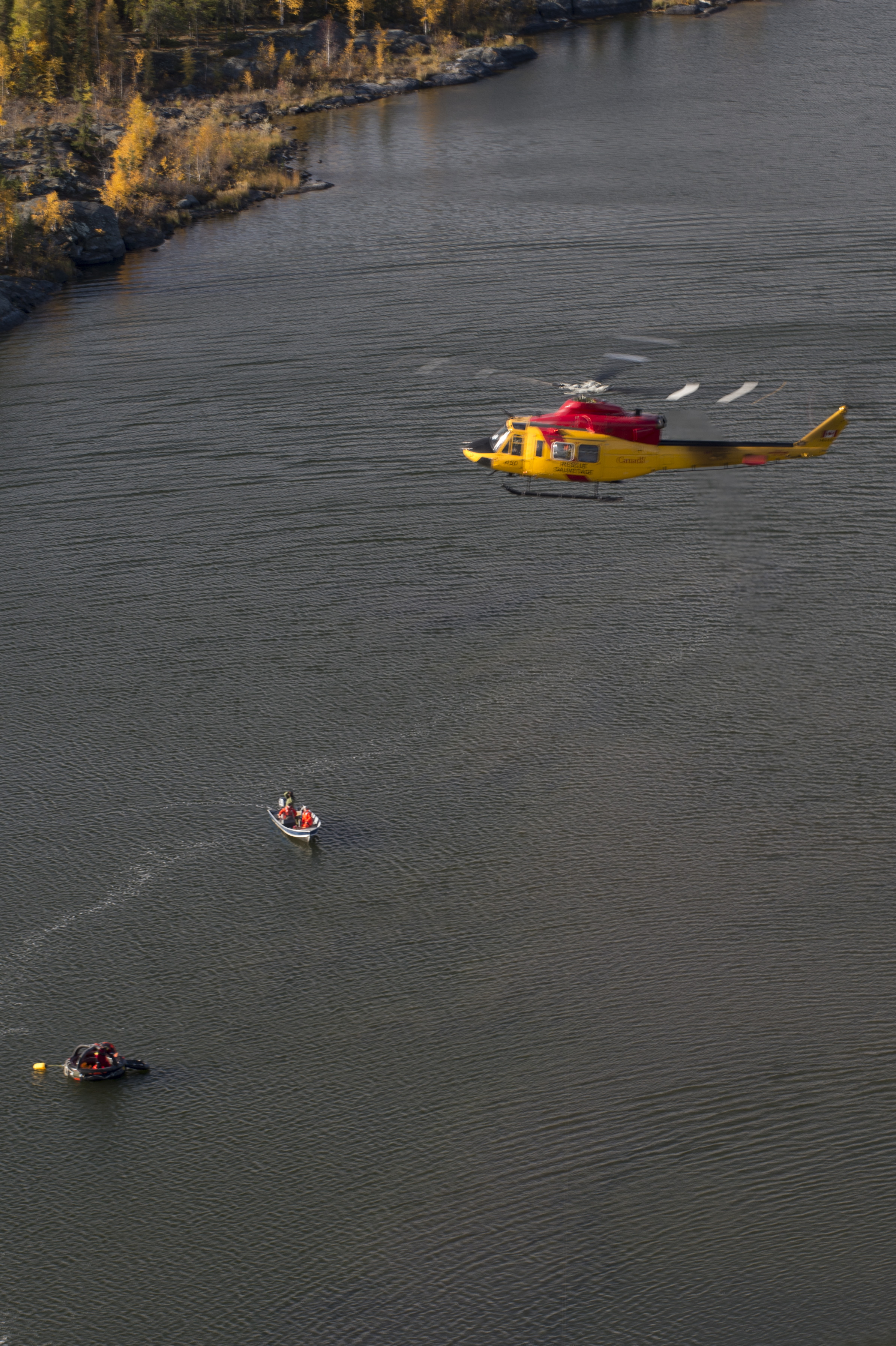National search and rescue exercise wraps up in Yellowknife
News Article / September 29, 2016
To see more images, click on the photograph under "Image Gallery".
From Royal Canadian Air Force
9 Wing Gander’s 103 Search and Rescue Squadron emerges as best overall SAR squadron
A national search and rescue (SAR) exercise (SAREX) conducted in Yellowknife, Northwest Territories, from September 18 to 24, 2016, highlighted the importance of conducting real-world SAR missions and training to ensure crews are ready to respond when Canadians are in distress.
The value of the Royal Canadian Air Force exercise was further underlined when exercise participants unexpectedly provided real-time assistance to a canoeist in distress on Great Slave Lake, Northwest Territories and, in a separate incident, rescued four individuals from a remote area near Ulukhaktok, Northwest Territories.
In the spirit of traditional, friendly competition during National SAREX 2016, 103 Search and Rescue Squadron from 9 Wing Gander, Newfoundland and Labrador, won the Diamond Trophy by emerging as the best overall SAR squadron after five intense exercise days.
“The National SAREX is a strategic enabler, allowing for valuable interaction between the Canadian Armed Forces and other government and non-government partners, which strengthens our ability to operate efficiently for possible SAR missions,” said Major-General Christian Drouin, the commander of 1 Canadian Air Division, headquartered in Winnipeg. “I wish to thank all of those that contributed to this successful exercise and congratulate 103 Squadron on being named this year’s best overall SAR squadron.”
The annual exercise involved more than 230 participants and international guest observers. The training brought together the Department of Fisheries and Oceans, Environment and Climate Change Canada, Public Safety Canada and Transport Canada. The Civil Air Search and Rescue Association (CASARA), The Royal Canadian Mounted Police (RCMP) and ground search and rescue elements also played a prominent role during the major air disaster simulation that took place on Friday, September 23, 2016.
RCAF personnel from across Canada have now returned home after participating in the exercise, which provided a valuable opportunity for the RCAF’s SAR community to enhance readiness by participating in challenging training.
“This exercise brought together military SAR and combat support units from across Canada to train and exercise with their civilian counterparts in Yellowknife. Geography always presents unique challenges for SAR practitioners,” said Colonel Patrick Thauberger, the commander of 14 Wing Greenwood, Nova Scotia, which hosted the exercise in Yellowknife. “They must be prepared to deploy into any location and execute SAR techniques with, at times, other SAR units from across Canada and a variety of emergency and volunteer organizations. I commend the work performed by 14 Wing Greenwood members in hosting this year’s National SAREX and all those military and civilian SAR members who participated. They are truly a community of men and women, military and civilian, who are dedicated to finding and saving those that are lost or in danger, so that others may live.”
Along with their SAR partners, the RCAF is grateful to the Akaitcho Territorial Government, the Yellowknives Dene First Nation, as well as the people and municipal authorities of Yellowknife and the surrounding area, for the tremendous support and hospitality shown during National SAREX 2016.
RCAF SAR, transport, and other units that participated included:
- 103 Search and Rescue Squadron, 9 Wing Gander, Newfoundland and Labrador
- 413 Transport and Rescue Squadron, 14 Wing Greenwood, Nova Scotia
- 417 Combat Support Squadron, 4 Wing Cold Lake, Alberta
- 424 Transport and Rescue Squadron, 8 Wing Trenton, Ontario
- 435 Transport and Rescue Squadron, 17 Wing Winnipeg, Manitoba
- 439 Combat Support Squadron, 3 Wing Bagotville, Quebec
- 440 Transport Squadron, Yellowknife, Northwest Territories
- 442 Transport and Rescue Squadron, 19 Wing Comox, British Columbia
- 444 Combat Support Squadron, 5 Wing Goose Bay, Newfoundland and Labrador
- Canadian Forces School of Search and Rescue based at 19 Wing
- Representatives from the Joint Rescues Coordination Centers from Victoria, British Columbia; Trenton, Ontario; and Halifax, Nova Scotia
A variety of RCAF aircraft were used during the exercise, including:
- CH-149 Cormorant helicopter
- CH-146 Griffon helicopter
- CC-130H Hercules
- CC-138 Twin Otter
A number of other organizations participated, including:
- Public Safety Canada
- Fisheries and Oceans Canada
- Transport Canada
- Environment and Climate Change Canada
- Canadian Rangers
- The Royal Canadian Mounted Police
- Nav Canada
- The Civil Air Search and Rescue Association (CASARA)
- Yellowknife Airport


